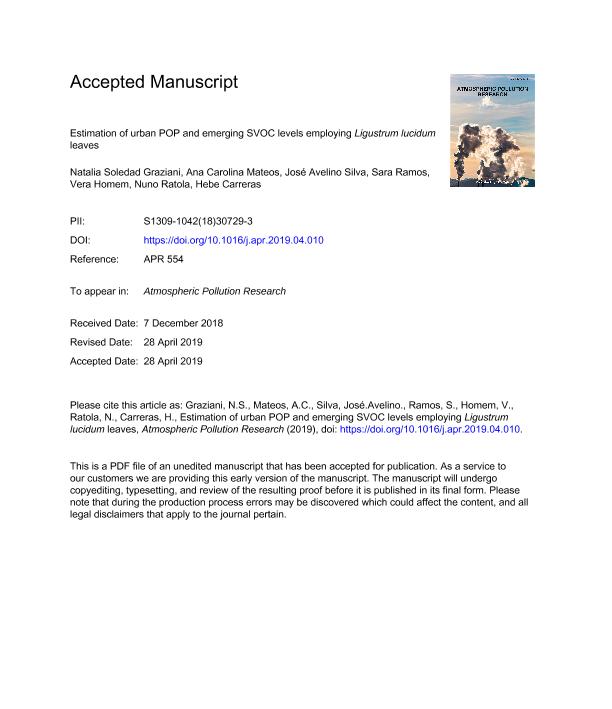Artículo
Estimation of urban POP and emerging SVOC levels employing Ligustrum lucidum leaves
Graziani, Natalia Soledad ; Tames, María Florencia
; Tames, María Florencia ; Mateos, Ana Carolina
; Mateos, Ana Carolina ; Silva, José Avelino; Ramos, Sara; Homem, Vera; Ratola, Nuno; Carreras, Hebe Alejandra
; Silva, José Avelino; Ramos, Sara; Homem, Vera; Ratola, Nuno; Carreras, Hebe Alejandra
 ; Tames, María Florencia
; Tames, María Florencia ; Mateos, Ana Carolina
; Mateos, Ana Carolina ; Silva, José Avelino; Ramos, Sara; Homem, Vera; Ratola, Nuno; Carreras, Hebe Alejandra
; Silva, José Avelino; Ramos, Sara; Homem, Vera; Ratola, Nuno; Carreras, Hebe Alejandra
Fecha de publicación:
09/2019
Editorial:
Elsevier B.V.
Revista:
Atmospheric Pollution Research
e-ISSN:
1309-1042
Idioma:
Inglés
Tipo de recurso:
Artículo publicado
Clasificación temática:
Resumen
Many persistent organic pollutants (POPs) have been banned in many countries including Argentina after enforcing the Stockholm Convention in 2014, while other emerging semi-volatile organic contaminants (SVOCs) are considered to enter the list due to their known environmental persistence and toxicity. However, there is still very little information regarding the distribution of these chemicals in the environment in developing countries. To address this issue, we employed leaves of Ligustrum lucidum Ait. as a passive monitor to estimate urban levels of polychlorinated biphenyls, brominated flame retardants and hexachlorobenzene (PCBs, BFRs, and HCB, respectively) considering three different land use areas in Córdoba city (Argentina). We found higher PCB values in urban and industrial areas, which could be attributed to local emission sources as well as a long-range transport of lightweight compound. BFRs were more abundant in the urban areas indicating that their main emission source is the volatilization from polymeric materials. HCB, on the other hand, was equally distributed at the three sampling areas. Overall, POP and SVOC levels were similar or even lower than some other urban environments and even comparable with remote places elsewhere.
Palabras clave:
BFRS
,
BIOMONITORING
,
HCB
,
LIGUSTRUM LUCIDUM
,
PCBS
Archivos asociados
Licencia
Identificadores
Colecciones
Articulos(IMBIV)
Articulos de INST.MULTIDISCIPL.DE BIOLOGIA VEGETAL (P)
Articulos de INST.MULTIDISCIPL.DE BIOLOGIA VEGETAL (P)
Citación
Graziani, Natalia Soledad; Tames, María Florencia; Mateos, Ana Carolina; Silva, José Avelino; Ramos, Sara; et al.; Estimation of urban POP and emerging SVOC levels employing Ligustrum lucidum leaves; Elsevier B.V.; Atmospheric Pollution Research; 10; 5; 9-2019; 1524-1530
Compartir
Altmétricas



